Abstract
The heavy-chain switch from immunoglobulin M (IgM) expression to IgA expression is mediated by a recombination event between segments of DNA called switch regions. The switch regions lie two to six kilobases upstream of the mu and alpha constant region coding segments. Switch recombination to IgA expression results in a recombinant mu-alpha switch region upstream of the expressed alpha constant region gene. We have characterized the products of switch recombination by a lymphoma cell line, I.29. Two sets of molecular clones represent the expected products of simple mu to alpha switches. Five members of a third set of molecular clones share the same recombination site in both the mu and the alpha switch regions, implying that the five molecular clones were derived from a single switch recombination event. Surprisingly, the five clones fall into two sets of sequences, which differ from each other by several point mutations and small deletions. Duplication of switch region sequences are also found in these five molecular clones. An explanation for these data is that switch recombination involves DNA synthesis, which results in nucleotide substitutions, small deletions, and duplications.
Full text
PDF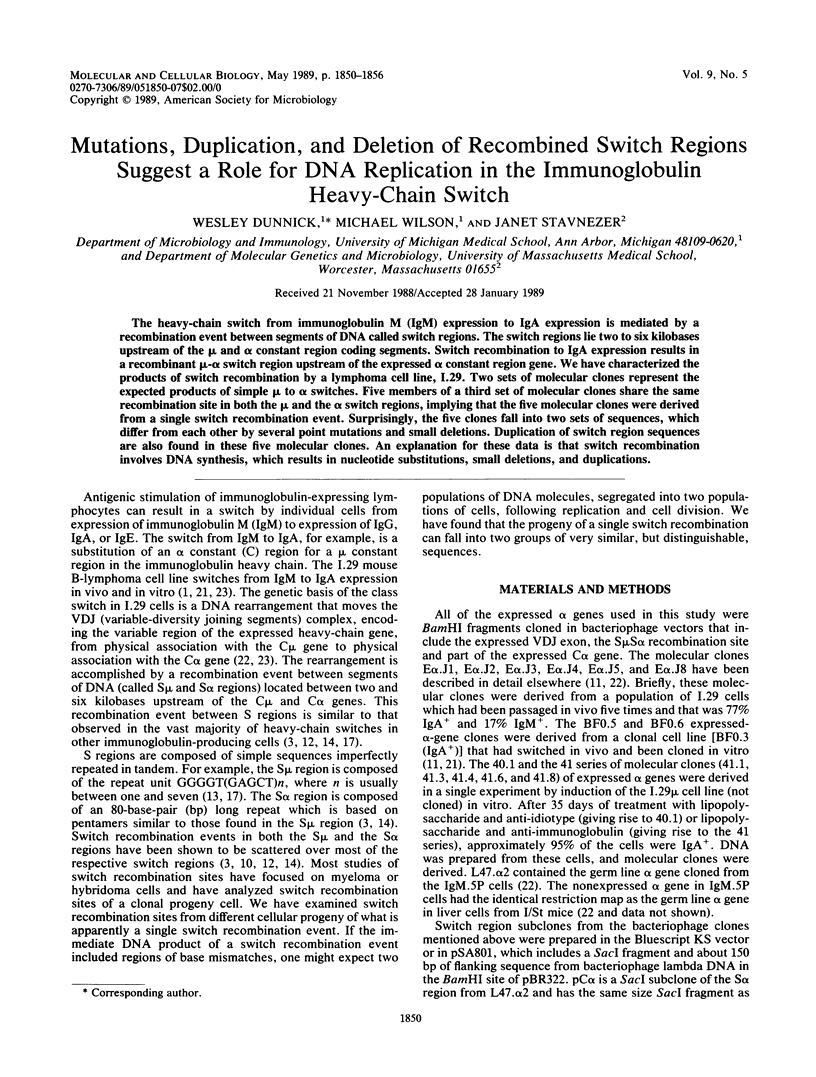
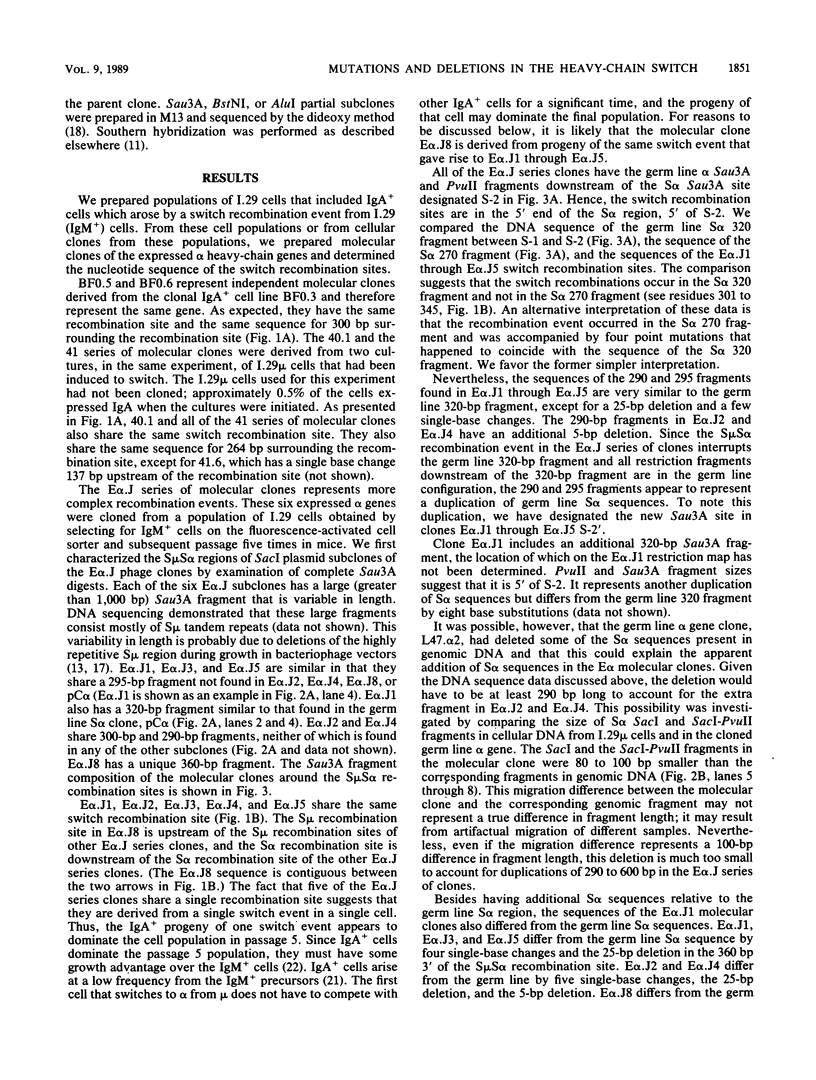
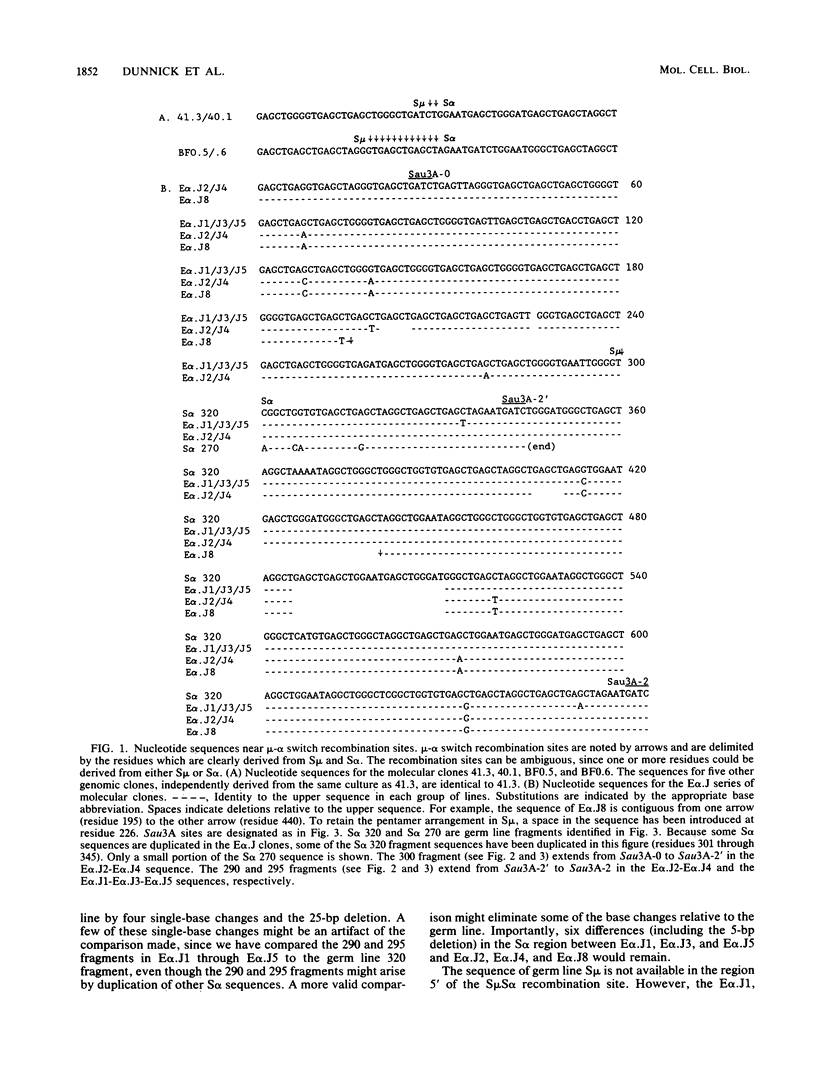
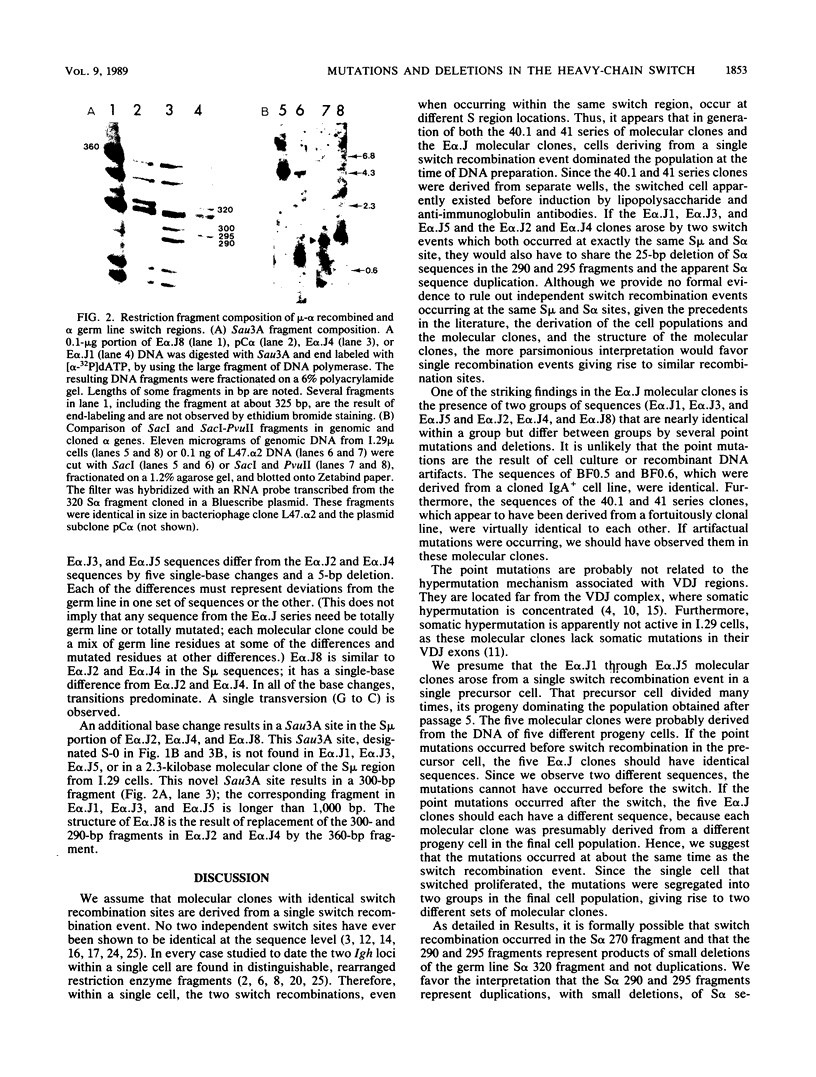
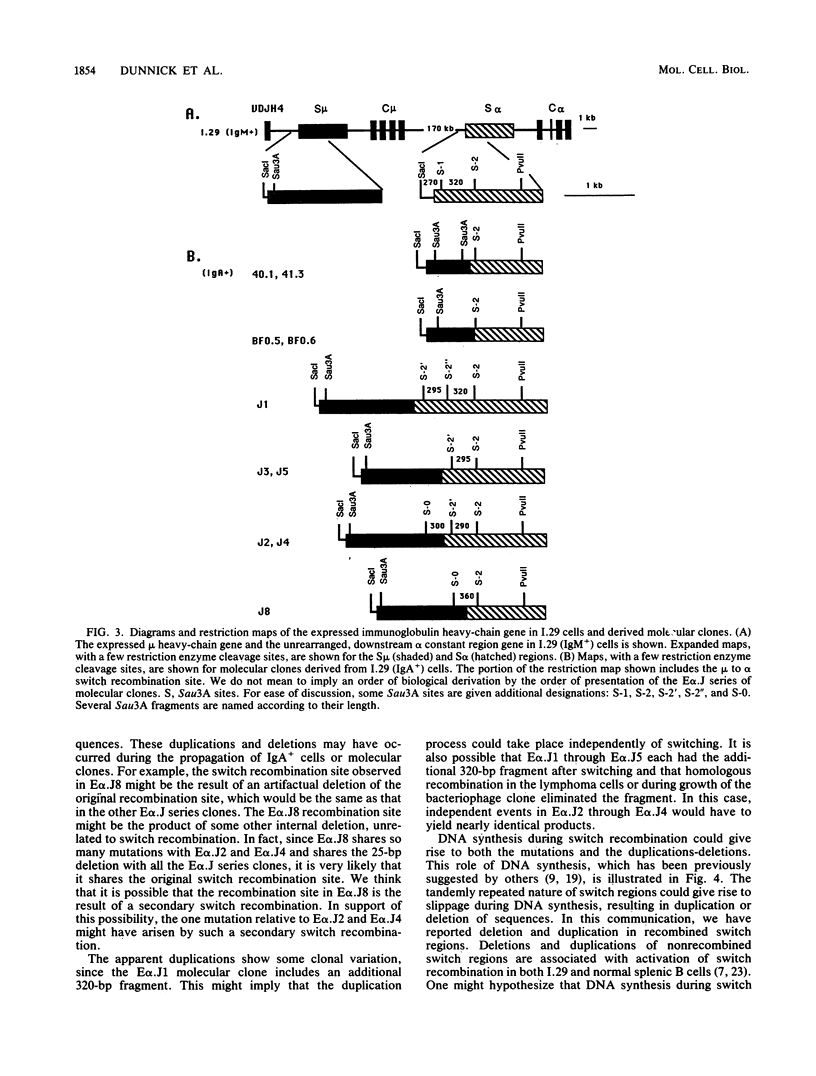
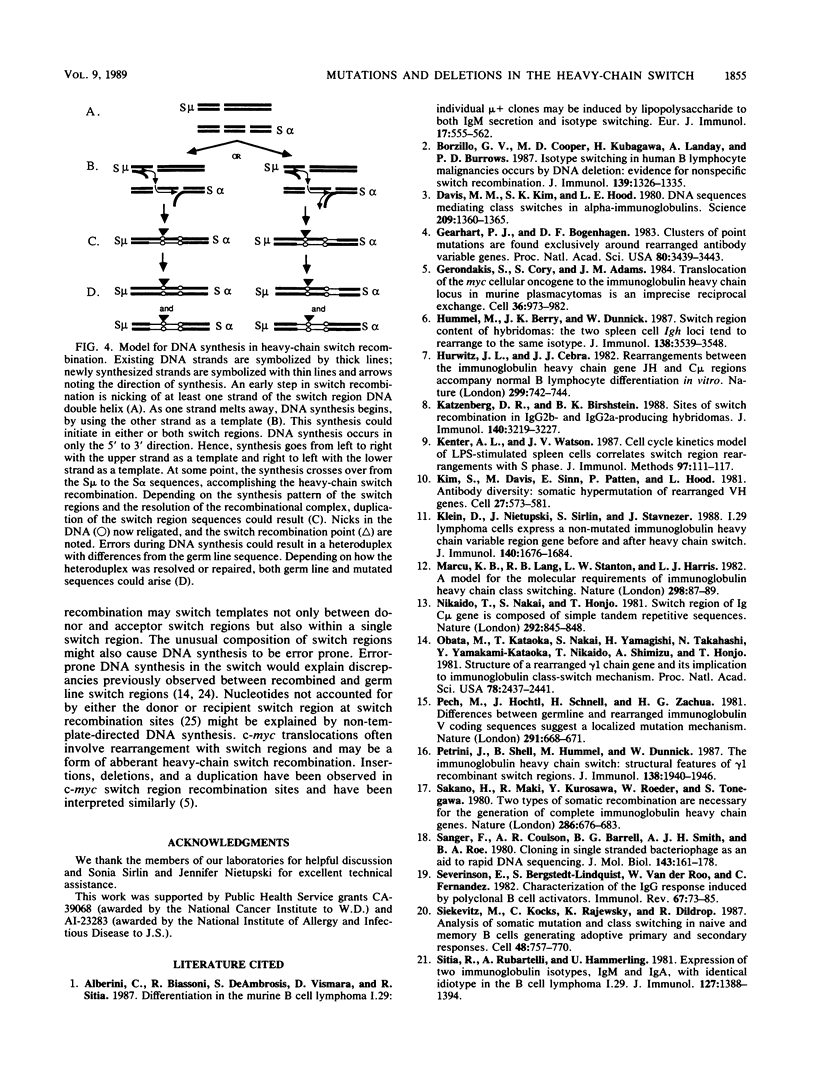
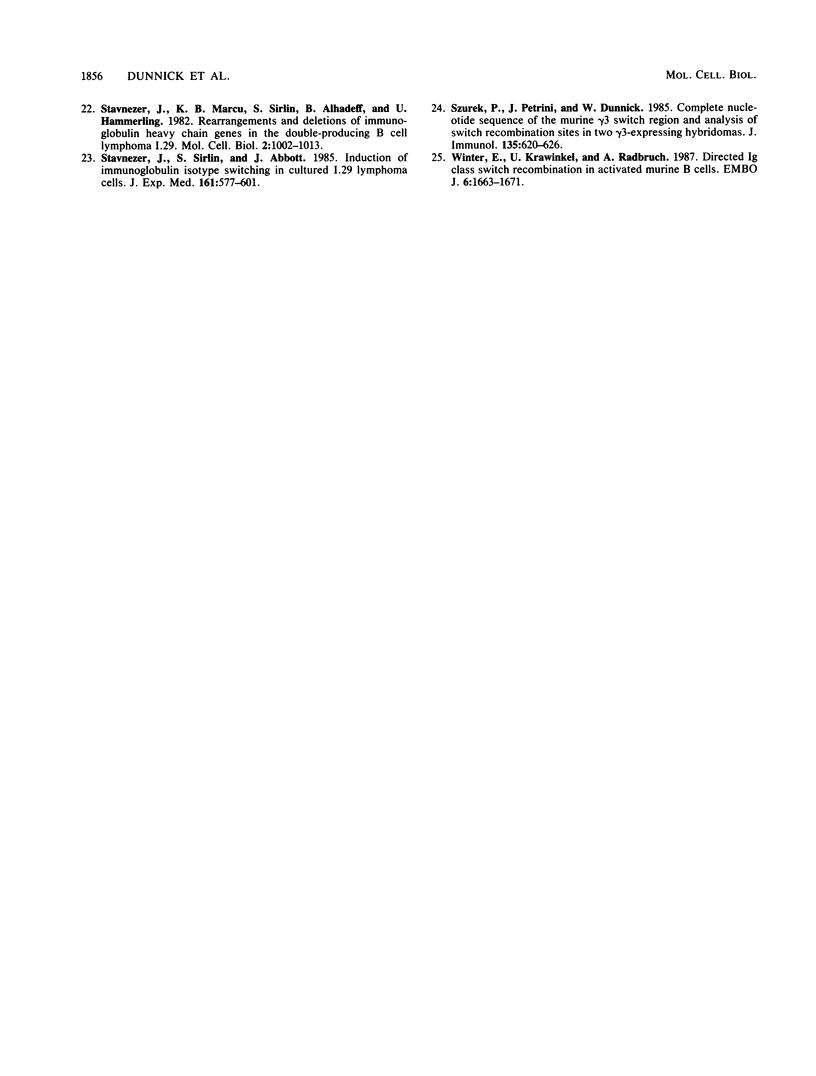
Images in this article
Selected References
These references are in PubMed. This may not be the complete list of references from this article.
- Alberini C., Biassoni R., DeAmbrosis S., Vismara D., Sitia R. Differentiation in the murine B cell lymphoma I.29: individual mu + clones may be induced by lipopolysaccharide to both IgM secretion and isotype switching. Eur J Immunol. 1987 Apr;17(4):555–562. doi: 10.1002/eji.1830170419. [DOI] [PubMed] [Google Scholar]
- Borzillo G. V., Cooper M. D., Kubagawa H., Landay A., Burrows P. D. Isotype switching in human B lymphocyte malignancies occurs by DNA deletion: evidence for nonspecific switch recombination. J Immunol. 1987 Aug 15;139(4):1326–1335. [PubMed] [Google Scholar]
- Davis M. M., Kim S. K., Hood L. E. DNA sequences mediating class switching in alpha-immunoglobulins. Science. 1980 Sep 19;209(4463):1360–1365. doi: 10.1126/science.6774415. [DOI] [PubMed] [Google Scholar]
- Gearhart P. J., Bogenhagen D. F. Clusters of point mutations are found exclusively around rearranged antibody variable genes. Proc Natl Acad Sci U S A. 1983 Jun;80(11):3439–3443. doi: 10.1073/pnas.80.11.3439. [DOI] [PMC free article] [PubMed] [Google Scholar]
- Gerondakis S., Cory S., Adams J. M. Translocation of the myc cellular oncogene to the immunoglobulin heavy chain locus in murine plasmacytomas is an imprecise reciprocal exchange. Cell. 1984 Apr;36(4):973–982. doi: 10.1016/0092-8674(84)90047-3. [DOI] [PubMed] [Google Scholar]
- Hummel M., Berry J. K., Dunnick W. Switch region content of hybridomas: the two spleen cell Igh loci tend to rearrange to the same isotype. J Immunol. 1987 May 15;138(10):3539–3548. [PubMed] [Google Scholar]
- Hurwitz J. L., Cebra J. J. Rearrangements between the immunoglobulin heavy chain gene JH and C mu regions accompany normal B lymphocyte differentiation in vitro. Nature. 1982 Oct 21;299(5885):742–744. doi: 10.1038/299742a0. [DOI] [PubMed] [Google Scholar]
- Katzenberg D. R., Birshtein B. K. Sites of switch recombination in IgG2b- and IgG2a-producing hybridomas. J Immunol. 1988 May 1;140(9):3219–3227. [PubMed] [Google Scholar]
- Kenter A. L., Watson J. V. Cell cycle kinetics model of LPS-stimulated spleen cells correlates switch region rearrangements with S phase. J Immunol Methods. 1987 Feb 26;97(1):111–117. doi: 10.1016/0022-1759(87)90112-8. [DOI] [PubMed] [Google Scholar]
- Kim S., Davis M., Sinn E., Patten P., Hood L. Antibody diversity: somatic hypermutation of rearranged VH genes. Cell. 1981 Dec;27(3 Pt 2):573–581. doi: 10.1016/0092-8674(81)90399-8. [DOI] [PubMed] [Google Scholar]
- Klein D., Nietupski J., Sirlin S., Stavnezer J. I.29 lymphoma cells express a nonmutated VH gene before and after H chain switch. J Immunol. 1988 Mar 1;140(5):1676–1684. [PubMed] [Google Scholar]
- Marcu K. B., Lang R. B., Stanton L. W., Harris L. J. A model for the molecular requirements of immunoglobulin heavy chain class switching. Nature. 1982 Jul 1;298(5869):87–89. doi: 10.1038/298087a0. [DOI] [PubMed] [Google Scholar]
- Nikaido T., Nakai S., Honjo T. Switch region of immunoglobulin Cmu gene is composed of simple tandem repetitive sequences. Nature. 1981 Aug 27;292(5826):845–848. doi: 10.1038/292845a0. [DOI] [PubMed] [Google Scholar]
- Obata M., Kataoka T., Nakai S., Yamagishi H., Takahashi N., Yamawaki-Kataoka Y., Nikaido T., Shimizu A., Honjo T. Structure of a rearranged gamma 1 chain gene and its implication to immunoglobulin class-switch mechanism. Proc Natl Acad Sci U S A. 1981 Apr;78(4):2437–2441. doi: 10.1073/pnas.78.4.2437. [DOI] [PMC free article] [PubMed] [Google Scholar]
- Pech M., Höchtl J., Schnell H., Zachau H. G. Differences between germ-line and rearranged immunoglobulin V kappa coding sequences suggest a localized mutation mechanism. Nature. 1981 Jun 25;291(5817):668–670. doi: 10.1038/291668a0. [DOI] [PubMed] [Google Scholar]
- Petrini J., Shell B., Hummel M., Dunnick W. The immunoglobulin heavy chain switch: structural features of gamma 1 recombinant switch regions. J Immunol. 1987 Mar 15;138(6):1940–1946. [PubMed] [Google Scholar]
- Sakano H., Maki R., Kurosawa Y., Roeder W., Tonegawa S. Two types of somatic recombination are necessary for the generation of complete immunoglobulin heavy-chain genes. Nature. 1980 Aug 14;286(5774):676–683. doi: 10.1038/286676a0. [DOI] [PubMed] [Google Scholar]
- Sanger F., Coulson A. R., Barrell B. G., Smith A. J., Roe B. A. Cloning in single-stranded bacteriophage as an aid to rapid DNA sequencing. J Mol Biol. 1980 Oct 25;143(2):161–178. doi: 10.1016/0022-2836(80)90196-5. [DOI] [PubMed] [Google Scholar]
- Severinson E., Bergstedt-Lindqvist S., van der Loo W., Fernandez C. Characterization of the IgG response induced by polyclonal B cell activators. Immunol Rev. 1982;67:73–85. doi: 10.1111/j.1600-065x.1982.tb01056.x. [DOI] [PubMed] [Google Scholar]
- Siekevitz M., Kocks C., Rajewsky K., Dildrop R. Analysis of somatic mutation and class switching in naive and memory B cells generating adoptive primary and secondary responses. Cell. 1987 Mar 13;48(5):757–770. doi: 10.1016/0092-8674(87)90073-0. [DOI] [PubMed] [Google Scholar]
- Sitia R., Rubartelli A., Hammerling U. Expression of 2 immunoglobulin isotypes, IgM and IgA, with identical idiotype in the B cell lymphoma I.29. J Immunol. 1981 Oct;127(4):1388–1394. [PubMed] [Google Scholar]
- Stavnezer J., Marcu K. B., Sirlin S., Alhadeff B., Hammerling U. Rearrangements and deletions of immunoglobulin heavy chain genes in the double-producing B cell lymphoma I.29. Mol Cell Biol. 1982 Aug;2(8):1002–1013. doi: 10.1128/mcb.2.8.1002. [DOI] [PMC free article] [PubMed] [Google Scholar]
- Stavnezer J., Sirlin S., Abbott J. Induction of immunoglobulin isotype switching in cultured I.29 B lymphoma cells. Characterization of the accompanying rearrangements of heavy chain genes. J Exp Med. 1985 Mar 1;161(3):577–601. doi: 10.1084/jem.161.3.577. [DOI] [PMC free article] [PubMed] [Google Scholar]
- Szurek P., Petrini J., Dunnick W. Complete nucleotide sequence of the murine gamma 3 switch region and analysis of switch recombination sites in two gamma 3-expressing hybridomas. J Immunol. 1985 Jul;135(1):620–626. [PubMed] [Google Scholar]
- Winter E., Krawinkel U., Radbruch A. Directed Ig class switch recombination in activated murine B cells. EMBO J. 1987 Jun;6(6):1663–1671. doi: 10.1002/j.1460-2075.1987.tb02415.x. [DOI] [PMC free article] [PubMed] [Google Scholar]



